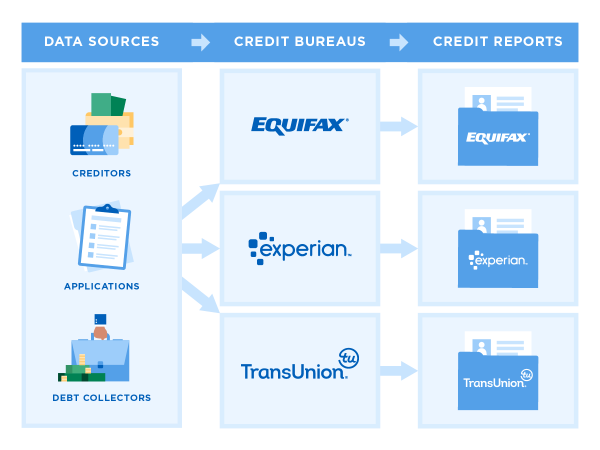The right data bureau will offer their services in the most transparent and flexible way, as well as be a valuable asset to your credit risk team. But how do you know if your current bureau is the ‘right fit’?
If you’ve decided to review existing suppliers, you probably have no idea where to begin your research. On the other hand, you might be wary of approaching a new data bureau, if you’ve worked with the same one for many years.
The good news? We can guarantee that you will be able to work out if a bureau is the perfect match for you by understanding what to look out for. And we’re here to help.
In this article, we explore five vital signs to look out for that will help you to understand if your current bureau is the right fit – starting with a quick look at the current data bureau landscape.
The UK data bureau landscape
Today, in the UK, there are three major credit bureaus (or CRAs); Equifax, Experian, and TransUnion.

(Image source: nerdwallet)
Each bureau’s scoring system is akin to a “secret recipe” because they all use proprietary models to generate credit scores. These models consider a variety of data points, such as paySo what are the common areas to consider if your current data bureau is meeting your needs?
The 5 vital signs to understand if your current bureau is the right fit
There are certain signs you should be on the lookout for when assessing whether your current bureau is the right fit and meeting all your needs.
Here’s a round-up of the top 5 signs:
1. They meet all your data needs
Firstly, they absolutely must meet all your data needs. And by this, we mean data quality and accuracy. It’s common knowledge that there are key differences in the data held by the bureaux and the level of quality, coverage, and completeness.
2. They fit your budget
A very common reason is simply due to budgets and available spend. While bureau data is definitely not something you should skimp on, you shouldn’t be paying more than your competitors and peers.
💡Did you know: Based on our estimates, at least 90% of lenders have inflated pricing – paying more than their competitors and peers.
3. They offer flexible contracts
You’ll only get the best results when your chosen bureau offers flexibility with your data contract. That way, they can create an effective contract which can flex with the peaks and troughs in demand.
So, before you dive straight in and sign the contract, you need to make sure the bureau in question embeds this kind of flexibility from the start.
4. They have a trustworthy reputation
A considerable part of your decision should be whether the bureau has a trustworthy reputation.
Make sure to check your bureau’s credentials, whether that’s looking at case studies and testimonials or getting in touch with references. Also, don’t be afraid to nit-pick your chosen bureau to see if they can ‘walk the walk and talk the talk’.
A great data bureau should have a fantastic reputation for data quality and accuracy. It might also be worth asking previous clients for feedback.
5. They offer overall value
The final thing to consider is what language does the bureau speak in; cash or value? In the world of CRAs, bigger is not always better. It’s tempting to opt for a big CRA, especially if you’re a big lender.
But choosing a big CRA for your business is not always the answer. And the size of you as a lender doesn’t matter either. Some smaller customers get better pricing than larger customers, mainly due to larger customers not being able to move easily and a potential lack of competitive leverage. One major element that bigger CRAs struggle to offer is more personalised, flexible, and bespoke data contracts.
Find the right bureau to meet your needs
Some things are a match made in heaven. Similarly, lenders and CRAs should fit together perfectly.
When weighing up which bureau to work with, it’s worth getting full transparency into data pricing, quality, and accuracy. By conducting data benchmarking, you will be able to quickly and easily work that out, and whether they will be a good fit for your organisation.ment history, credit utilisation, length of credit history, types of credit in use, and recent applications for credit, but they weigh these factors differently, making each scoring model unique.
Furthermore, the effectiveness or relevance of a particular scoring system can vary by industry or sector. The ‘ingredients’ or data points a model uses, and how it balances them, can have significant implications for the sort of risks it can identify and mitigate effectively.
Another essential factor to consider is the ability of a scoring model to prevent fraud. Some models may be equipped with sophisticated algorithms that can detect potential fraudulent activity more effectively than others. This becomes incredibly important in sectors where there is a high risk of fraud.
All of which underpins the importance of ‘retros’ (retrospective analyses) to continuously evaluate the effectiveness of a scoring system – as well as looking at the price.
👉The main thing to take away is this: With only a handful of bureaux, it’s hard to know if you’re getting the best deal. Unlike risk technology, competition isn’t anywhere near as rife. Therefore, it’s not uncommon for lenders to stick with the same data bureau for many many years.
But unfortunately, this can lead to poor practices like a lack of data pricing transparency.
- SEO Powered Content & PR Distribution. Get Amplified Today.
- PlatoData.Network Vertical Generative Ai. Empower Yourself. Access Here.
- PlatoAiStream. Web3 Intelligence. Knowledge Amplified. Access Here.
- PlatoESG. Automotive / EVs, Carbon, CleanTech, Energy, Environment, Solar, Waste Management. Access Here.
- BlockOffsets. Modernizing Environmental Offset Ownership. Access Here.
- Source: https://www.finextra.com/blogposting/24454/is-your-current-data-bureau-meeting-your-needs?utm_medium=rssfinextra&utm_source=finextrablogs
- :has
- :is
- :not
- :where
- $UP
- a
- ability
- Able
- absolutely
- accuracy
- activity
- afraid
- algorithms
- All
- also
- always
- an
- Analyses
- and
- answer
- anywhere
- applications
- approaching
- ARE
- areas
- article
- AS
- Assessing
- asset
- At
- available
- away
- balances
- based
- BE
- because
- becomes
- before
- begin
- being
- benchmarking
- bespoke
- BEST
- Better
- Big
- bigger
- Budgets
- Bureau
- business
- but
- by
- CAN
- case
- Case Studies
- Cash
- certain
- check
- choosing
- chosen
- clients
- Common
- competition
- competitive
- competitors
- conducting
- Consider
- considerable
- continuously
- contract
- contracts
- coverage
- CRA
- create
- Credentials
- credit
- Current
- Customers
- data
- data points
- deal
- decided
- decision
- definitely
- Demand
- differences
- do
- does
- Doesn’t
- Dont
- due
- each
- easily
- Effective
- effectively
- effectiveness
- either
- element
- Equifax
- equipped
- especially
- essential
- estimates
- evaluate
- existing
- Experian
- explore
- factor
- factors
- fantastic
- feedback
- final
- fit
- Flexibility
- flexible
- For
- fraud
- fraudulent
- fraudulent activity
- from
- full
- generate
- get
- getting
- good
- great
- guarantee
- hand
- handful
- Hard
- Have
- Held
- help
- here
- High
- history
- How
- HTTPS
- idea
- identify
- if
- image
- implications
- importance
- important
- in
- incredibly
- industry
- into
- IT
- Key
- Kind
- Know
- knowledge
- Lack
- landscape
- language
- larger
- lead
- least
- lender
- lenders
- Length
- Level
- Leverage
- like
- Look
- looking
- made
- Main
- mainly
- major
- make
- Making
- many
- Match
- Matter
- May..
- mean
- Meet
- meeting
- might
- Mitigate
- model
- models
- more
- most
- move
- must
- Near
- Need
- needs
- New
- news
- no
- of
- offer
- Offers
- on
- ONE
- only
- or
- organisation
- Other
- Others
- our
- out
- overall
- part
- particular
- paying
- perfect
- Personalised
- plato
- Plato Data Intelligence
- PlatoData
- points
- poor
- potential
- practices
- prevent
- previous
- price
- pricing
- probably
- proprietary
- quality
- question
- Quick
- quickly
- reason
- recent
- recipe
- references
- relevance
- reputation
- research
- Results
- review
- right
- Risk
- risks
- s
- same
- scoring
- Secret
- sector
- Sectors
- see
- Services
- should
- sign
- significant
- Signs
- Similarly
- simply
- Size
- smaller
- some
- something
- sophisticated
- Source
- speak
- spend
- start
- Starting
- straight
- Struggle
- studies
- such
- suppliers
- sure
- system
- Take
- Talk
- team
- Technology
- than
- that
- The
- the UK
- the world
- their
- Them
- There.
- therefore
- These
- they
- thing
- things
- this
- three
- to
- together
- top
- top 5
- touch
- Transparency
- transparent
- Transunion
- trustworthy
- types
- Uk
- Uncommon
- understand
- understanding
- unfortunately
- unique
- unlike
- use
- uses
- utilisation
- Valuable
- value
- variety
- Ve
- very
- vital
- Way..
- we
- weigh
- weighing
- WELL
- What
- when
- whether
- which
- while
- will
- with
- Work
- work out
- worked
- world
- worth
- years
- You
- Your
- zephyrnet













